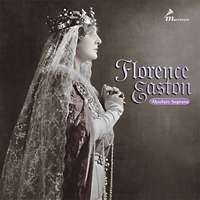
Florence Easton: Absolute Soprano
Florence Easton (1882-1955) claims a place of honor in the annals of opera. Few sopranos have sung a wider range of repertoire. Only a handful can match her uncompromising musicianship. None surpasses her ability to learn a role and perform it within hours. And yet, although colleagues and critics alike esteemed her artistry, few today rank Easton among the vocal elite. Perhaps she was a singer's singer: a consummate professional who one could count on for a faultless performance and yet, remains forgotten. This two-CD set, with notes by Robert Baxter, pays tribute to an indispensable hero of the Met whose artistry deserves remembering.
A Note from Ward Marston
|
Florence Easton is one of those singers who simply never made a bad record. Throughout her entire career, she maintained a vocal and musical consistency at which one can only marvel. Her three recordings of “Un bel dì,” for example, are all sung with impeccable security and with a remarkable similarity of interpretation. Easton was certainly not a spontaneous singer but this is more than outweighed by the fact that she sang everything so well. In preparing this compilation, I have chosen the music which best represents Easton’s incredible diversity. I have included most of the operatic material that she recorded together with two groups of Lieder and lighter material sung in Spanish, Italian, and English. The most conspicuous omission from this set is Easton’s most celebrated recording, the final scene from Siegfried with Lauritz Melchior. Having already appeared several times on compact disc, I have decided to present other less often heard Easton recordings. Florence Easton made her first group of recordings in 1918 for the Aeolian-Vocalion company in New York City. They include eight operatic and five song titles. In order to circumvent the patent rights held by U. S. Victor and Columbia, the Vocalion company recorded their discs using the vertical or “hill and dale” method. These discs could not be played on a standard gramophone and consequently, they sold very poorly. Today, they are extremely rare and almost always turn up in battered condition. The sonic quality of these discs is not terribly good, the voice being distant and yet distorted on loud passages. Thus, from this Vocalion group, I have only included selections not duplicated by Easton’s later acoustic recordings. Late in 1919, the patent restriction on lateral recording was lifted and Vocalion immediately switched to this more generally accepted recording method. Easton made three lateral sides for Vocalion, only one of which replaced her earlier vertical recordings. Florence Easton’s last group of acoustic discs were recorded for American Brunswick and date from 1921 through 1926. These are extremely well-recorded and give one a much clearer idea of the sound of Easton’s voice than her earlier Vocalion discs. It is unfortunate that this group includes only eleven operatic titles since her broad repertoire would have allowed her to record so many more. Florence Easton continued to record for Brunswick as it made its transition from acoustic to electric recording. Sadly, her only operatics from this group are two duets with tenor Mario Chamlee, one of which is presented here. Her other Brunswick electrical sides consist of titles in English including some poorly chosen ones such as “I’se gwine back to Dixie,” “Croon croon underneat’ de moon,” and “Little old log cabin in the lane.” Easton stopped recording for Brunswick in 1928 but during that same year, she made six operatic sides for the Edison company which had just recently switched to electrical recording. They are all beautifully sung although only the two Wagner selections were published at the time. Test pressings of all six sides have been preserved at the Edison National Site in West Orange, New Jersey and thanks to their generosity, I have been able to include them in this compendium. No tribute to Florence Easton could be complete without the six sides cut in London with Gerald Moore at the piano. Oddly enough, these recordings were financed by RCA Victor but recorded by HMV. She is in fine voice here and one can only lament that additional titles, especially Lieder, were not recorded. Fortunately, a portion of Easton’s 1939 Julliard recital was issued by the International Record Collectors Club, albeit from a poorly dubbed acetate source. Despite a wide spread search that I conducted among collectors, I was not able to find any trace of the original discs. Thus my transfers of this material had to be taken from the I. R. C. C. 78 rpm dubs. Because of time constraints, I have only been able to include ten of the thirteen items originally issued. The extract from Liszt’s oratorio, “The Legend of Saint Elizabeth,” which concludes this compilation, was recorded especially for the I. R. C. C. | ||